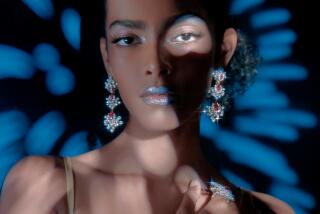ARTISANS: Spotlighting makers of hand-crafted goods : Tiffany Lights Artist’s Way
Louis Comfort Tiffany, a celebrated artist and decorator whose glassware designs helped define the art nouveau style first popularized in the 1890s, died in 1933 at the age of 85. While Tiffany himself is long gone, he’d probably take comfort in knowing that his work, characterized by the linear depiction of sinuous, floral forms, lives on.
Original Tiffany vases and lamps can sell at auction in New York or Paris for as much as $500,000. For those whose budgets aren’t quite so extravagant, a local artist reproduces Tiffany-like lamp shades that can be as difficult to differentiate from the real Tiffanys as live sound from Memorex.
Dee Ann Moore of San Clemente studied her craft during a decade-long association with Paul Crist, one of the world’s foremost experts on stained glass and a specialist on Tiffany lamps.
“He’s often flown all over the world to authenticate Tiffany’s work,” says Moore, 34. “One of Crist’s original lamp shades turned up in a book on the best of Tiffany, and he’s testified in a number of court cases where a lamp shade being passed off as an authentic Tiffany turned out to be one Crist had made himself” in his Santa Fe Springs studio.
The apprentice has had a similar experience. She was recently perusing antiques in an exclusive Palm Springs store when she spied a Tiffany lamp on sale for $150,000.
“The only reason I knew that lamp wasn’t real was because I made it,” laughs the artist.
Moore started Deelightful Heirlooms a year and a half ago, using a workshop in her garage to produce custom-made Tiffany reproduction lamps.
All of her work is custom-made to the buyer’s specifications. She uses an established design pattern to re-create the Tiffany style. Clients select from a palette of colors, or seek her advice as a “colorist.” She cuts the glass, assembles the pieces on a template, then affixes them on a mold. An outside company does the finishing work.
She prefers working at night, when the vibrantly colored glass is at its most alluring.
For each piece of glass used in the finished product, another has been disregarded due to breakage or other problems associated with production.
What’s the toughest part of reproducing a Tiffany lamp?
“The coloring,” she says without hesitation. “Clients will pick out photos and say they want to come close to this. It’s nearly impossible to get the exact shades.”
Moore buys most of her glass from John Triggs, a glass chemist whose company, the Youchagigheny Opalescent Glass Co. in Connellsville, Pa., outside Pittsburgh, produces glass similar to that once used by Tiffany. Moore has visited the plant several times to participate in the glass-making process.
“I think John’s lifelong dream is to create glass that’s identical to Tiffany’s,” Moore says. “No one’s really been able to do it. They don’t know the process, how Tiffany got the colors that he got. There’s no recipe, and after actually going back there and making glass myself, it appears to be a hit-and-miss kind of thing. You throw in a little bit of this chemical and little bit of that chemical.
“The timing is real important, and so is the temperature. You can re-create the glass, and then do the same exact thing again and it won’t turn out the same.
“Making glass is just a delicate, delicate process. If it’s heated up a couple of degrees too hot, you can end up with something completely opaque. If you do certain things, they call it striking, you can end up with something that’s too translucent. If you add a teaspoon of one chemical too much, you might end up with a green instead of a blue.”
Tiffany lamps are prized collector’s items, cherished for their quality craftsmanship, graceful designs and brilliant colors.
Even when they were new, Tiffany lamps were expensive. A Dragonfly lamp sold for $80 in 1906, while a 1913 Poinsettia model went for $200.
No one really knows how many originals have survived, according to Moore.
A Moore reproduction can take up to 200 hours to produce. She has created between 75 and 150 reproductions on her own, and contributed to many more during her years at Paul Crist Studios.
“No lamp can be reproduced exactly,” Moore states. “Every lamp is different, every lamp has its own personality, its own color pattern.”
Her prices vary depending on the complexity of the pattern and the number of stained glass pieces that compose the work. A relatively simple Tiffany reproduction costs $2,500, while an extremely intricate model--containing as many as 1,260 separate pieces of stained glass--can run up to $14,500.
Although she prefers Tiffany reproductions, she’s not necessarily limited to that.
“Yes, I do windows,” she admits, referring to stained glass ones, “though they’re not my favorites. But, if the price is right, I will do them.”


